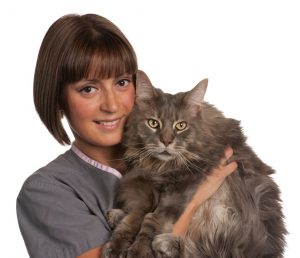Paper describes causes of and new treatments for hip dysplasia in cats

It is not typically difficult for an owner to notice when their dog develops hip dysplasia or osteoarthritis. When a dog starts limping, panting, or refusing to play, owners recognize that there is a problem. Cats, however, aren’t usually expected to play catch or take walks with their human companions, and their medical conditions may not be as obvious.
A new paper from Michigan State University examines potential causes of hip dysplasia in cats, and describes therapies for treating the condition, relieving our feline friends of pain, and possibly saving their lives.
The incidence of hip dysplasia in domestic shorthair cats is low, just over 5 percent, but runs as high as 20 percent in purebred cats. The Maine Coon, Persian, and Himalayan breeds are most likely to be affected.
“The high rate of affliction in certain breeds may be secondary to the larger body size of these breeds,” said author Dr. Karen Perry, a specialist in orthopedics with a particular interest in cats and an assistant professor at the MSU Veterinary Medical Center. “It may also be the result of a narrower gene pool—hip dysplasia is recognized to be an inherited disease in a number of species.”
Clinical signs of hip dysplasia usually develop gradually in cats. It can take some time to notice the signs of pain as the cat becomes less active, has an increasingly difficult time jumping and climbing stairs, or becomes reluctant to squat while using the litter box.
Unalleviated chronic pain may contribute to behavioral problems. A cat that develops physical limitations and pain may become agitated or aggressive and erode the human–animal bond. This may ultimately lead to surrender or even euthanasia, and so becomes a welfare concern.
“It is important to address pain in cats,” said Perry. “As with humans, hip dysplasia in cats is a significant risk factor for osteoarthritis. There is little doubt that cats with hip dysplasia and associated osteoarthritis suffer pain, and this warrants appropriate therapy.”
"Cats are not just small dogs."
-Karen Perry
Scientists are not certain how hip dysplasia develops in cats. In humans and dogs, the disease is signaled by loose hips around the time of birth. Dogs that develop hip dysplasia usually are born with normal bone structure, but changes occur in the first several months of life that then lead to abnormal joint development, osteoarthritis, and sometimes hip dislocation.
There are several challenges to diagnosing hip dysplasia in cats. The loose joints seen in dogs and humans aren’t clearly associated with the disease in felines, nor is joint dislocation. Degenerative changes tend to develop later and are less marked than in the dog. Changes in the cat are often most pronounced affecting the acetabulum, the socket of the hip joint, while the femoral head, or ball of the hip joint, often remains relatively unaffected.
Diagnostics for feline hip dysplasia
When examining the hip, veterinarians should perform abduction in addition to flexion, extension, and rotation. Cats with hip dysplasia and associated osteoarthritis generally resent hip abduction, sometimes more so than flexion and extension.
Most cats respond to non-surgical management with a combination of environmental changes, physical therapy, drug therapy, or weight loss. If these changes don’t adequately relieve the cat’s pain, there are two surgical options available: femoral head and neck excision and total hip replacement.
Read the full report in the Journal of Feline Medicine and Surgery.
